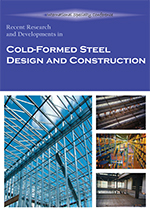Session Dates
24 Aug 2012 - 25 Aug 2012
Abstract
This paper investigates the 3D temperature fields of the shot-nailed steel roof sheeting joints in fire using commercial Finite Element (FE) software ABAQUS when the connected members and connections are protected by either intumescent paint or rockwool panels. Numerical models and parameters used in the models are briefly introduced. When expanded in fire, both thickness and thermal conductivity are varied with increased temperatures. The simplified representation of intumescent paint is described. Parametric analyses are performed in order to investigate the sensitivity of the parameters of thermal contacts. When the joints are protected with rockwool panels, the approximate cavity radiation method in ABAQUS is used to take the cavity radiation into account among the surfaces of the profiled steel sheeting and fire protection panel. The 3D temperature fields in the proximity of shot-nail connections from above mentioned fire protection solutions are compared. The benefits of using various fire protection solutions are discussed.
Department(s)
Civil, Architectural and Environmental Engineering
Research Center/Lab(s)
Wei-Wen Yu Center for Cold-Formed Steel Structures
Meeting Name
21st International Specialty Conference on Cold-Formed Steel Structures
Publisher
Missouri University of Science and Technology
Document Version
Final Version
Rights
© 2012 Missouri University of Science and Technology, All rights reserved.
Document Type
Article - Conference proceedings
File Type
text
Language
English
Recommended Citation
Ma, Z.; Lu, W.; Mäkeläinen, P.; and Outinen, J., "Prediction of Joint Temperatures in Shot-nailed Cold-formed Steel Sheeting with Finite Element Modelling" (2012). CCFSS Proceedings of International Specialty Conference on Cold-Formed Steel Structures (1971 - 2018). 4.
https://scholarsmine.mst.edu/isccss/21iccfss/21iccfss-session9/4
Prediction of Joint Temperatures in Shot-nailed Cold-formed Steel Sheeting with Finite Element Modelling
This paper investigates the 3D temperature fields of the shot-nailed steel roof sheeting joints in fire using commercial Finite Element (FE) software ABAQUS when the connected members and connections are protected by either intumescent paint or rockwool panels. Numerical models and parameters used in the models are briefly introduced. When expanded in fire, both thickness and thermal conductivity are varied with increased temperatures. The simplified representation of intumescent paint is described. Parametric analyses are performed in order to investigate the sensitivity of the parameters of thermal contacts. When the joints are protected with rockwool panels, the approximate cavity radiation method in ABAQUS is used to take the cavity radiation into account among the surfaces of the profiled steel sheeting and fire protection panel. The 3D temperature fields in the proximity of shot-nail connections from above mentioned fire protection solutions are compared. The benefits of using various fire protection solutions are discussed.



